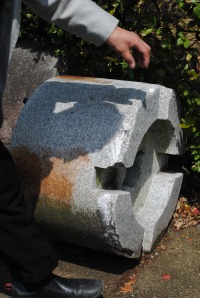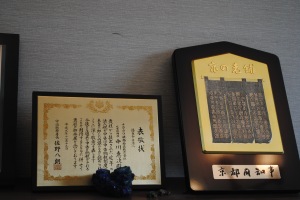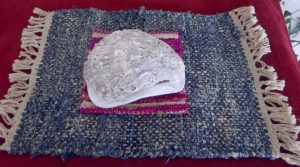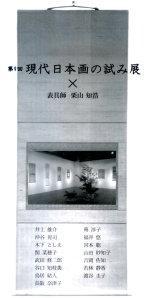 Nous avons rendu visite à Mr Nakagawa dont l’entreprise est située à Uji, au sud de Kyoto. Il nous a très généreusement proposé de visiter sa fabrique de pigments et de nous accompagner ensuite au temple Ujigami et Byodo-en, deux sanctuaires inscrits au patrimoine mondial de l’humanité de l’UNESCO.
Nous avons rendu visite à Mr Nakagawa dont l’entreprise est située à Uji, au sud de Kyoto. Il nous a très généreusement proposé de visiter sa fabrique de pigments et de nous accompagner ensuite au temple Ujigami et Byodo-en, deux sanctuaires inscrits au patrimoine mondial de l’humanité de l’UNESCO.
Mr Nakagawa nous a d’abord reçu dans son bureau, dans lequel on peut découvrir sur des étagères tous les pigments qui ont fait le bonheur des peintres nihonga depuis des décénies.
Monsieur Nakagawa parle très bien l’anglais en tous cas mieux que moi. Je lui ai expliqué que nous étions un certain nombre à rêver trouver ses pigments en France, c’est pourquoi j’ai fait la démarche de les faire connaitre à des distributeurs tels que Laverdure, ou Sennelier.
Monsieur Nakagawa s’étonne presque que des occidentaux s’intéressent à ses produits. Dernièrement il a même eu la visite d’un journal allemand! Le journal Mare. Il faut dire que Kremer, distributeur allemand des pigments Nakagawa , en fin connaisseur de la beauté et de la qualité des pigments a su faire partager ces précieux produits sans peur de la concurrence alors qu’il produit par ailleurs lui même aussi ses pigments..
Les mystères du commerce font que les distributeurs français qui revendent par exemple du gofun, préfèrent le commander à Kremer plutôt que directement à Mr Nakagawa, multipliant ainsi par 3 ou 4 le prix d’origine. Allez comprendre… J’ai appris ainsi que les pigments que Monsieur Nakagawa fournit à l’entreprise Kremer, sont conçus spécialement pour l’exportation, et répondent aux normes de sécurité européennes, ils sont donc exempts de toxicité. Attention donc pour ceux qui achètent leur pigments au Japon, qui n’applique pas ces normes, de bien faire attention à certains pigments en particulier le vermillon naturel.
Sur les murs de son bureau sont accrochés des petits tableaux que l’on peut trouver en kit dans le commerce. En effet, dans sa volonté d’offrir au plus grand nombre la possibilité de gouter au nihonga, Mr Nakagawa a créé des kits pour créer de petits tableaux, composés d’un motif, de pigments minéraux, de pinceaux et de supports préparés: http://www.eokaku.com/japanese/02/japanese01.html
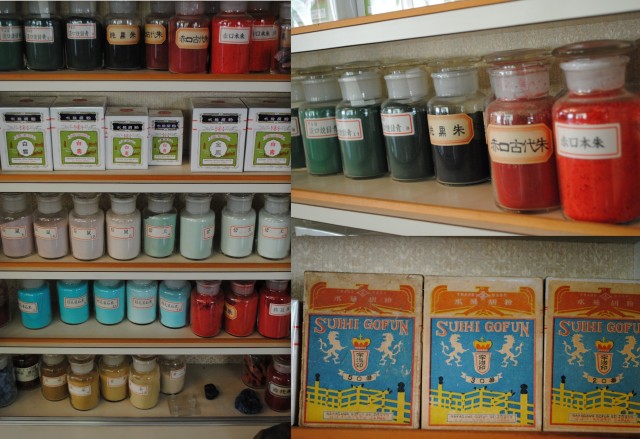
Je reprends ci-dessous un article très complet:
http://tucsoncitizen.com/morgue2/1999/02/12/166974-now-that-s-earth-tones/
L’entreprise familiale de Mr Nakagawa a démarré il y a plus de 100 ans, avec son arrière grand père.
Mr Nakagawa, raconte que son arrière-grand-père a commencé à travailler avec le gofun, le pigment blanc tiré de coquilles d’huître moulues.
Le Gofun, aussi appelé blanc de coquillage, a remplacé le blanc dans le maquillage du visage après que l’on découvrit que le blanc de plomb était toxique.
Les couches poncées et polies d’une laque de gofun opaque sont ce qui donne leur surface blanche lisse, luminescente et soyeuse aux poupées japonaises traditionnelles.
Le Gofun est aussi nutritif et peut être mangé mélangé avec des haricots blancs et du sel.

Après la Deuxième Guerre mondiale, le père de Mr Nakagawa a commencé à travailler avec des minéraux.
Azurite et malachite ont traditionnellement été utilisées dans la fabrication de pigments minéraux, mais Nakagawa Gofun Enogu Co. Ltd. Travaille maintenant avec 40 minéraux différents pour tirer 400 couleurs, avec des nuances basées sur la taille des grains.
La gamme de pigment Azurite s’étend d’une fine poudre de talc bleu pâle à un bleu roi brillant aux grains d’une taille 25 fois plus gros.
La société de Nakagawa, qui fait aussi des pigments synthétiques, réalise la gamme de couleur au cours d’un processus qui prend deux ans.
Un morceau de 650 livres d’azurite, par exemple, est d’abord cassé en morceaux plus petits, qui sont alors séparées par couleur ou nuances de couleur. Le processus est répété plusieurs fois, les morceaux de plus en plus petits sont écrasés et séparés.
Une nouvelle séparation est faite par lévigation répétée, qui implique le mélange des particules de roche avec de l’eau et de laisser reposer le mélange. Les particules plus grossières se déposent au fond.
Une roche d’azurite de 650 livres rapportera 65 livres de pigment de catégorie supérieure et 65 livres de pigment de la deuxième catégorie. Le reste est jeté.
“Nous produisons seulement la pureté. C’est pourquoi nous jetons les autres couleurs,” dit Mr Nakagawa.
En prenant un flacon de la taille d’une bouteille de pilules, d’une poudre bleu saphir faite d’azurite, il a évalué qu’elle est pure à plus de 99 pour cent.. Il aimerait dire 100 pour cent, mais il a admis qu’enlever tous les polluants est presque impossible.

Parmi les clients de Nakagawa on trouve l’artiste japonais Kaii Higashiyama, qui utilise beaucoup de malachite et d’ azurite dans ses œuvres
Sa peinture “l’Écho Vert” montre un cheval blanc dans une forêt luxuriante de pins bleu-vert.
“La Marée dans l’Aube,” une immense scène océanique de platine et d’or , a sa une place dans le palais de l’empereur au Japon.
Les artistes doivent faire attention de ne pas ingérer ou aspirer les pigments, dit il, mais “s’ils savent comment contrôler le pigment, ceux-ci sont très frais pour eux, et très nouveaux.”
Haruo Nakagawa vend des pigments à base de minéraux comme le grenat, le jade, le corail et Jasper. Les pigments sont utilisés pour faire des peintures naturelles, qui sont parfois utilisées dans la restauration d’art.”
Reprenons la visite:
Près des batiments de la fabrique s’élèvent des montagnes de coquilles. Les coquilles reflètent la lumière du ciel et nous sommes presque éblouies. Ces coquilles produiront le gofun.
Les coquilles resterons ainsi une dizaine d’année à l’air libre afin que se décompose toute la matière organique. Le temps accordé à ce processus fait toute la qualité de ce pigment. Cette coquille d’huitre est de l’espèce Itabo-gaki , on la trouve dans la mer intérieur du Japon: La mer Seto. Enfin aux dernières nouvelles elle serait en voie de disparition, et des études pour l’élever sont en cours. Monsieur Nakagawa ne semble pas inquiet de ce fait: il lui reste quelques dizaines d’années de stock, dit il… La coquille du dessus est d’une qualité plus fine que la coquille inférieure. On utilise les deux pour créer différentes qualités de gofun.

Nous découvrons les machines qui permettront dans un premier temps d’éroder les coquilles, de les broyer, et de les moudre avec des meules comme dans nos moulins à farine. Ci dessous une vieille meule en pierre qui n’est plus utilisée.
Les pigments sont décantés dans plusieurs bassins. Chaque affinage produit un pigment de plus en plus fin. Ainsi on produira différentes qualités de gofun

La pate formée sera étalée sur une planche de cyprès. L’ouvrier nous fait une démonstration et me propose d’en faire autant. Ce n’est pas compliqué il suffit de savoir faire les crèpes. Bon j’avoue, malgré mes origines bretonnes ce n’est pas mon fort et après une tentative, je préfère laisser faire le spécialiste.
Ces galettes seront entreposées en extérieur afin de les laisser sécher.
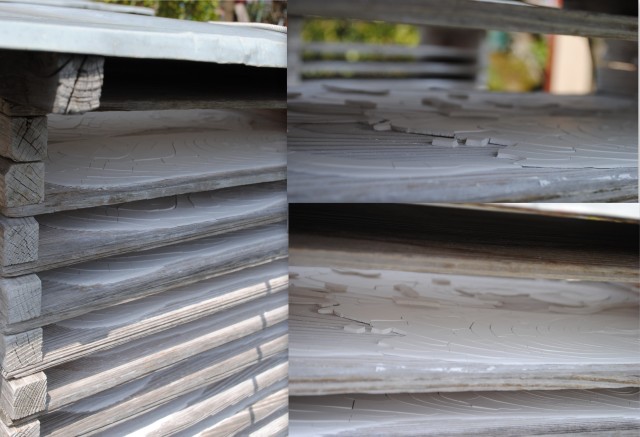
Les plaques de gofun sont ensuites décolées, puis stockées avant d’être réduites en poudre puis conditionnées.
Mr Nakagawa produit également des pigments de couleur en teintant artificiellement le gofun
La visite est terminée, nous revenons au bureau où je fais quelques achats. Monsieur Nakagawa me remets un catalogue et il m’offre en sus des pigments minéraux et le nouveau gofun qui ne nécessite pas d’adjonction de colle. Prêt à l’emploi, il suffit d’y ajouter de l’eau! Ici présenté sur le site nihonga100
Je n’aurai jamais de mots assez fort pour remercier Monsieur Nakagawa de son accueil et pour sa grande générosité qui n’a d’égal que sa simplicité.
Outre les deux articles cités cidessus, vous pourrez trouver des informations en français sur le gofun dans le livre de yiching Chen et en anglais dans le livre An Illustrated Dictionary of Japanese-Style Painting Terminology

